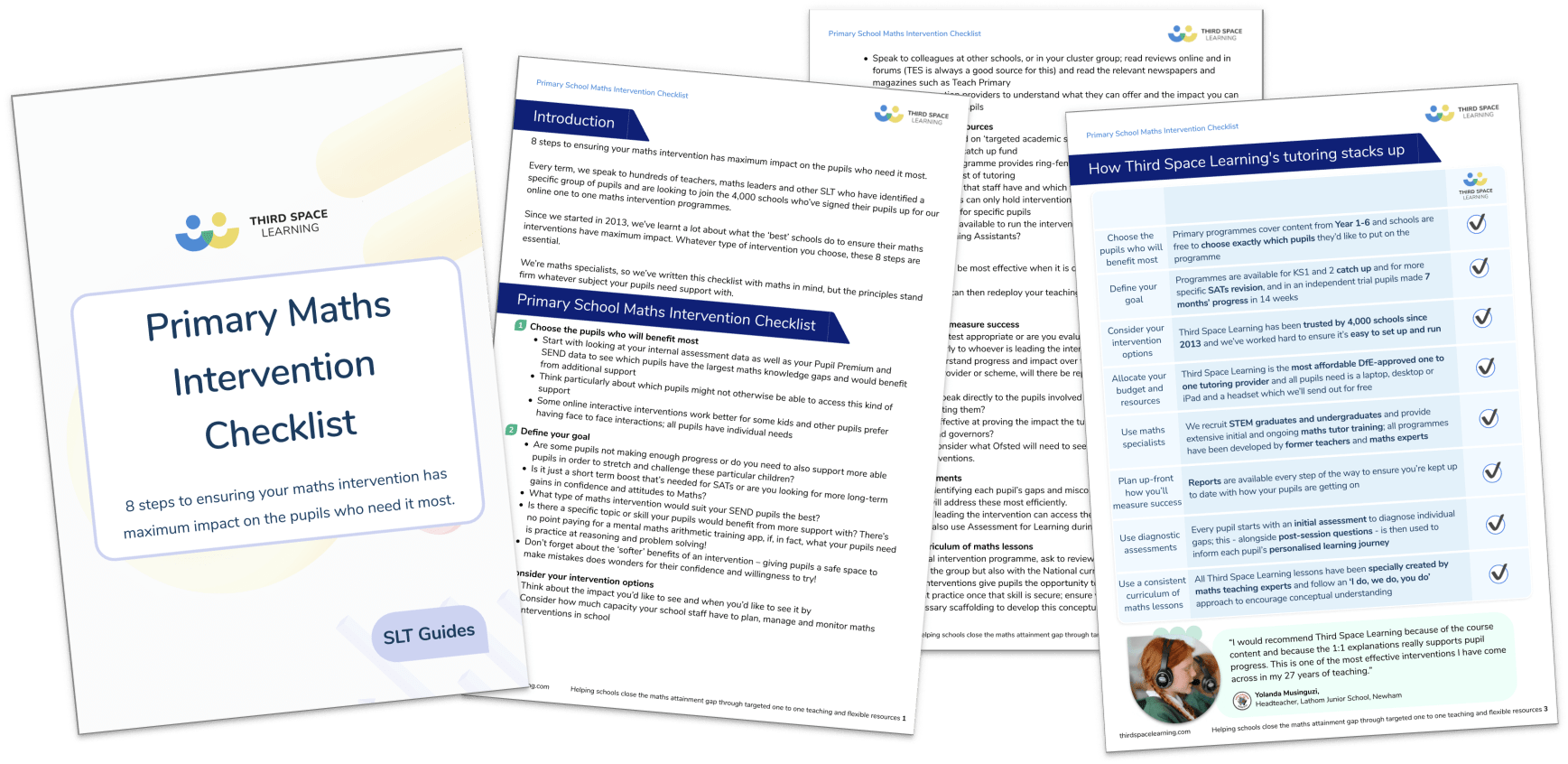9 Ways To Ensure Your Maths Intervention In KS2 Is Targeted And Effective
In this article, we’re looking at how to deliver an effective maths intervention for KS2 at primary school. We’ve drawn together the common threads we hear from talking with hundreds of teachers and school leaders every week, as well as our own experience as the UK’s largest provider or in-school one to one maths tutoring.
At Third Space Learning, we specialise in one-to-one maths intervention programmes as we believe one to one online maths tutoring is the most effective, efficient and affordable way to make rapid progress in maths. However, we understand that this isn’t always going to suit the needs of every school. This is why we’re taking a broad look at all the options available to you for your maths intervention.
- What are effective maths interventions?
- How to kick start your KS2 maths intervention strategy
- Look at the data from your own internal assessments
- Assess the size of your maths intervention needs
- A maths intervention doesn’t have to be all or nothing
- Decide if you can resource an effective maths intervention using your own staff
- What if you can’t resource your maths interventions using current staff?
- Considerations when choosing a KS2 maths intervention programme
- 1. Identify the pupils who need support
- 2. Understand your reasons for an intervention
- 3. Assess your budget or resources for a numeracy intervention
- 4. Do your research into the maths interventions available and which will work in your school
- 5. Plan in advance how you’re going to measure and report on the effectiveness of the intervention
- 6. Follow best practice to maximise impact of interventions
- 7. Think about the children not receiving the intense numeracy interventions
- 8. Ask detailed questions about the pedagogy of any maths intervention programme
- 9. Be aware of the common challenges around maths interventions
- Which sort of maths intervention should you choose?
- What next?
What are effective maths interventions?
Effective maths interventions at primary are educational initiatives and support given to pupils that occur in addition to their daily lessons in class.
The goal of these is usually to plug gaps in maths, but it can also be:
- to accelerate the speed of pupils’ learning;
- to develop understanding of particular mathematical concepts;
- to help pupils catch up after school closures;
- to support Year 6 pupils who are at risk of not meeting Age Related Expectations in maths SATs; or
- to build the confidence in maths some children need to progress.
These maths or numeracy interventions can take many forms at KS2, from expensive large scale programmes to internally resourced extra booster sessions run by a teaching assistant or specific intervention maths teacher.
Sadly, not all maths interventions actually answer the needs of the school who’s introduced it, which is why we are focusing this article on effective maths interventions: the ones that work.
For any primary school intervention to be effective, it needs to succeed on the terms you set for it whether that’s higher SATs results, improved reasoning or more maths talk in your school.
Read more: What The Best Catch Up Numeracy Programmes Look Like in Year 6
How to kick start your KS2 maths intervention strategy
Look at the data from your own internal assessments
It may be that after reviewing the Year 6 tracking data for the first half of term, you experience a faint feeling of despair. The curriculum gaps in maths that some pupils need to overcome before SATs begin to reveal themselves!
Every Third Space Learner taking part in our own maths intervention programmes starts with a pre-programme diagnostic assessment to identify curriculum gaps and craft an individual programme to cover the learning objectives pupils need to work on most.
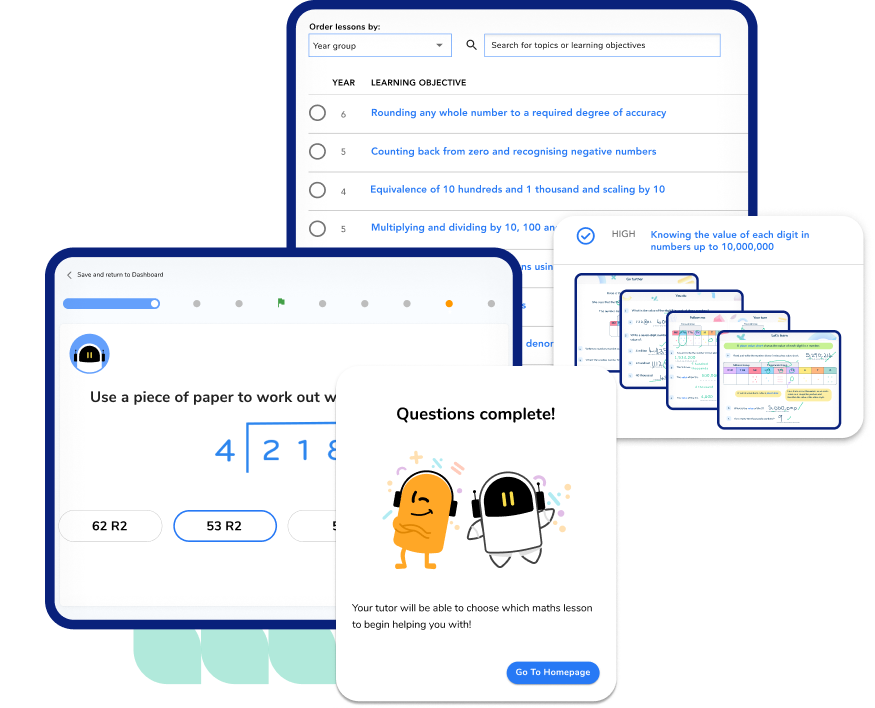
The diagnostic assessment programme is really great and useful. Although it personalises the lessons to the specific pupil, it still allows us to have input and we really enjoyed that flexibility.
Lindsey Lynd, Deputy Headteacher, St Paul’s Catholic Junior School, Liverpool
Perhaps at a meeting with the maths coordinator, or KS2 phase leader, you discover that already lower down the school, a couple of children in Year 4 or Year 5 are persistently not meeting their age related expectations.
Or maybe you’re aware it’s actually more of a whole school issue that needs to be addressed – perhaps recent assessments have highlighted problem solving as an issue across the key stages?
Whatever the issue, until you’ve looked in detail at your school’s most recent maths assessment data, ideally broken down by topic and domain, uou won’t have a good source of truth to base your decision making on.
Assess the size of your maths intervention needs
If it’s a whole school issue, you may be looking at an intensive, high-cost primary numeracy strategy.
If it’s just one or two children, you might simply need to nip any mathematical misconceptions in the bud.
But what’s most likely is that you’ve got several pupils, in different year groups, who need regular catch up maths interventions to enable them to access and keep up their whole class maths lessons.
A maths intervention doesn’t have to be all or nothing
Children in every age group deserve the opportunity to develop the knowledge, skills and confidence in maths to help them progress. If it looks like the current model at your school isn’t working, it might be a good idea to see what needs changing.
But don’t panic, an effective maths intervention doesn’t need to cost huge amounts of money!
Hundreds and probably thousands of schools are in similar situations to you, and there is a broad range of primary school tutoring and intervention programmes you can look at particularly for maths; not all of them are high-cost and many of them are proven to really make the difference you need.
Primary School Maths Intervention Checklist
Essential step-by-step checklist to help you select, manage and evaluate the best (and most cost-effective!) KS2 maths intervention programmes for your pupils
Download Free Now!Decide if you can resource an effective maths intervention using your own staff
The first step for any school looking to implement an effective maths intervention is to look at your own resources.
Do you have HLTAs or maths specialist teaching staff who you can rely on to deliver additional maths support that fulfils different pupils’ needs? Consider whether you can then redeploy your teaching assistants to cover for these expert maths teaching staff.
Are your teaching staff trained and confident to teach maths interventions or do they need additional training? Are they willing and able to shuffle their timetable to provide the additional support?
Some schools find, with a bit of creative timetabling, and increasing use of catch up, same day interventions they are able to resource the extra support their pupils need internally.
Some schools can only hold maths interventions after school. Other schools use assembly time to run interventions for specific pupils.
What if you can’t resource your maths interventions using current staff?
Not all schools have teaching assistants with the necessary skills and training to deliver interventions. In fact, research by the EEF has found that interventions run by teaching assistants without appropriate support from a qualified teacher can have little impact on student outcomes.
Some class teachers may also appreciate support in teaching mathematics, and in breaking down mathematical concepts and developing maths skills at the deeper level required for KS2 pupils.
You may simply decide that staff workload is already too high to then ask staff to also plan, manage and monitor a maths intervention programme.
We knew organising and running tutoring in-house was feasible but it’s a big job that would require lots of communication between staff. There was also no guarantee that we would have found enough teachers. That’s why we chose Third Space Learning. It runs so smoothly that I can let a class of 15 pupils get on with the tutoring while I get on with other tasks I need to complete.
Jon Kilbane, Deputy Headteacher and Maths Lead, St Michael’s Primary School, Reading
If this is the case, you will need to look to an external provider for your primary school’s maths intervention programme. If you’re looking to use your school’s National Tutoring Programme funding to work with an external tutoring organisation, you will need to ensure they are an approved DfE Tuition Partner, like Third Space Learning.
The rest of this article focuses on the considerations you’ll need to make when working with an external provider.
Considerations when choosing a KS2 maths intervention programme
Here we look at your options and what should you look for when choosing an effective KS2 maths intervention.
1. Identify the pupils who need support
Is it just three or four pupils in each year group, 15 pupils who are at risk of not making required progress or are you, in fact, looking for a whole class solution?
Do the children have any special educational needs or additional support requirements?
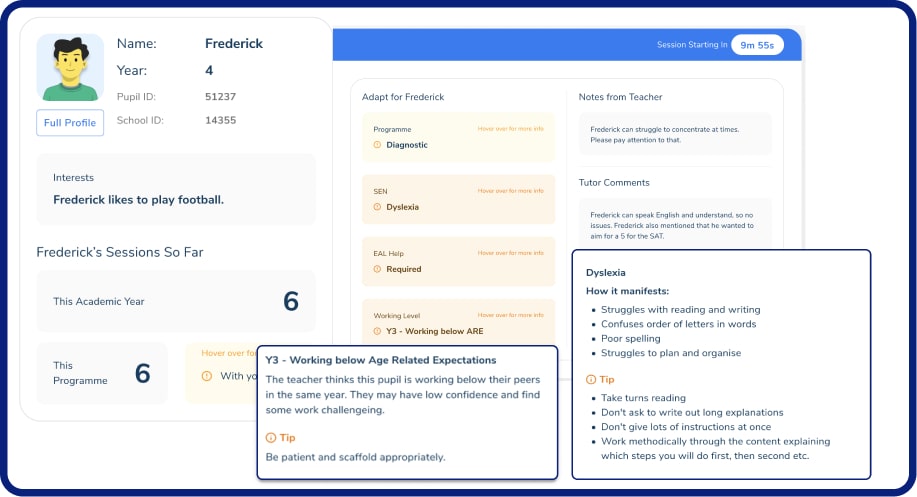
In our experience, and perhaps unsurprisingly, schools tend to choose pupils in upper KS2:
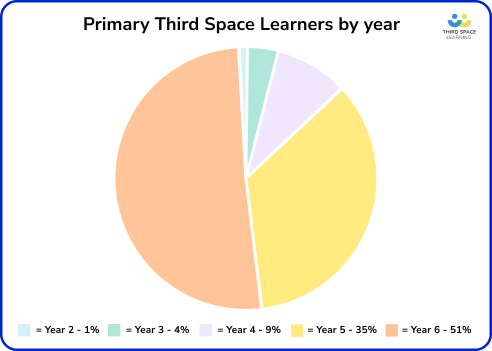
2. Understand your reasons for an intervention
These are some of the questions you should consider:
- Are pupils not making enough progress or do you need to also support more able pupils in order to stretch and challenge?
- Is it just a short term boost that’s needed for SATs or are you looking for more long-term gains in confidence and attitudes towards maths?
- Is it a couple of very specific learning gaps that need plugging or is there a general need to develop their reasoning skills?
- Are there children with specific mathematical difficulties that need to be addressed with this maths intervention?
3. Assess your budget or resources for a numeracy intervention
Many schools use their pupil premium funding for their maths interventions as often it is these children who need the help most.
In fact, the majority of pupils schools put forward for Third Space Learning’s online one to one maths tutoring are eligible for Pupil Premium funding.
But if you are targeting non-Pupil Premium children, you will need to consider how you can fund these pupils’ support or support them separately without spending money. Is there any unspent budget?
Can you do a deal with an intervention provider or join forces with other schools in your cluster or academy trust to improve your purchasing power?
And of course, while the National Tutoring Programme continues to run, make sure you’ve taken full advantage of the funding available to your school post Covid-19 pandemic to plug gaps. It’s worth noting that this tutoring funding is ring-fenced; that is, it cannot be spent on anything other than tutoring and if your school chooses not to spend it it will be clawed back at the end of the academic year.
Most providers, including Third Space Learning, are happy to agree a plan that fits an individual school, a group of schools or a multi academy trust budget.
Read more
- Third Space Learning: Pricing and Funding
- Explained: Your School’s Catch Up Funding Options
- 45 Pupil Premium Strategies To Close The Attainment Gap
- 10 Low Cost Pupil Premium Interventions
4. Do your research into the maths interventions available and which will work in your school
The next step is to research which maths intervention will support your pupils the best with the set-up you have.
If for example an intervention requires laptops or the internet and you know that your wifi connection only works in the morning (!) or in a certain area of the school, then factor this in when you’re selecting the intervention. Be prepared to be flexible.
Ask questions in Facebook groups or on Twitter. Get a first hand intervention review from teachers and head teachers. Take a look at the impact report and case studies that Third Space Learning provides for an idea of what to look for from other providers.
Talk to other schools or attend teachmeets, maths showcases (such as those that Third Space Learning run) or even education speed dating sessions. The great advantage of such local events is that often schools near you will have similar contexts and face similar challenges.
And don’t forget to refer to the EEF toolkit for an overview of effectiveness of intervention strategies in schools.
One to one tuition for example is proven to make +5 months’ additional progress but some providers are quite costly; at Third Space Learning, we’ve managed to reduce our costs to schools by delivering the maths interventions online. In fact, we’re proud to be the most affordable DfE-approved one to one maths tutoring provider.
5. Plan in advance how you’re going to measure and report on the effectiveness of the intervention
Just as you are held accountable by Ofsted for how you’re spending your Pupil Premium, or the measures you are putting in place to narrow the attainment gap, you should challenge any intervention provider to do the same.
For example, an effective maths intervention provider should be able to offer you a pre-test and post-test on the topics covered so that you can monitor progress in understanding.
If you are evaluating the softer skills of your pupils such as their confidence in maths, or an improved attitude and growth mindset, consider how any numeracy intervention programme can help you prove this.
Will case studies of individual pupils prove the impact your intervention had on your pupils to your headteacher and governors?
At Third Space Learning, we offer diagnostic tests before each pupil’s first session. This enables us to identify the gaps in learning that we will cover in sessions, but also provides a baseline assessment from which to measure progress made over time.
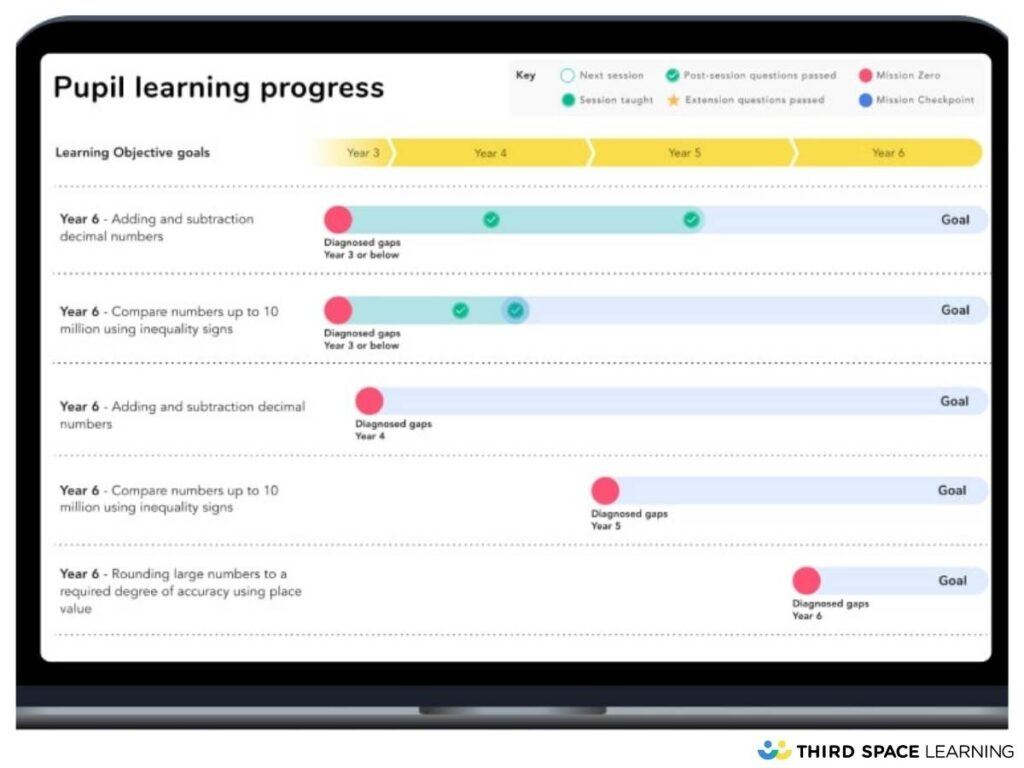
6. Follow best practice to maximise impact of interventions
Any effective maths intervention provider should have enough experience of the different ways schools have interacted with their intervention to be able to highlight how to get the most out of it, or indeed what challenges you might face.
Make sure, for example, that any KS2 maths intervention programme aligns with the approaches to teaching that pupils will experience in their whole-class lessons. Providers should adapt their teaching to match your calculation policy or primary maths scheme of work your following.
Look also at how the intervention impacts pupils’ attitudes to maths. Helping to build confidence and developing a growth mindset in maths will have long term benefits for years to come.
These pupils have many more years of maths ahead of them, and so often it’s the emotional barriers that need breaking down even more than the mental ones.
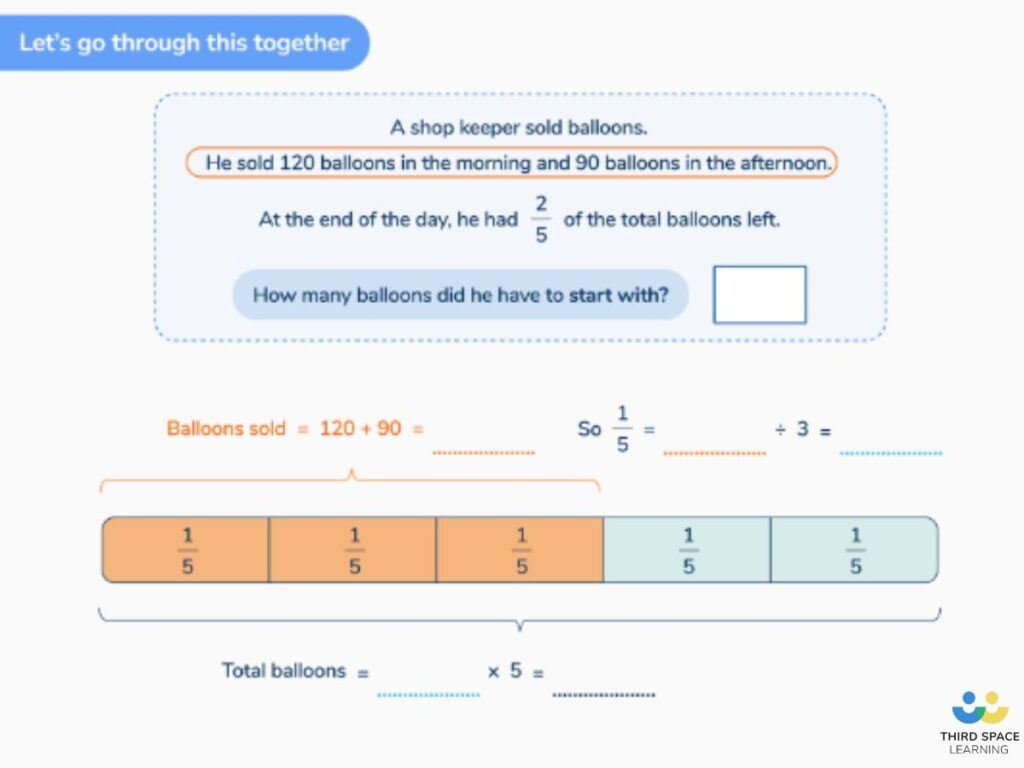
7. Think about the children not receiving the intense numeracy interventions
Try to ensure also that your maths intervention will have as wide-reaching an effect as possible.
With Third Space Learning, we aim to help raise attainment across the schools we work with, not only for pupils receiving tutoring with us. In addition to the sessions, schools have access to our toolkit of high quality teaching resources, assessment and online CPD through our online Maths Hub. This is free to join for all teachers (even if you’re not signed up for the tutoring), but schools who are signed up for the tutoring receive premium Maths Hub access at no additional cost.
Before you choose your maths intervention, speak to all the relevant staff members (headteachers, maths co-ordinators, other year group teachers, business managers) to establish what additional benefit they might derive from any maths intervention you choose.
Often the cheapest intervention (usually using your own staff to deliver it) may not be either the most effective, or the best value for money if you then have to think about how staff redeployment will affect other classes, and how you will cover or rearrange the timetable.
Once you know your budget you will have a better idea of what’s available to you and what the pros and cons might be.
8. Ask detailed questions about the pedagogy of any maths intervention programme
As a teacher or school leader, you’ll know what effective teaching looks like, but it can be difficult to pinpoint exactly what it entails. To help you ascertain if your maths intervention programme is developed and tested appropriately for maximum success, it’s worth checking at the start if it incorporates some of these essential maths strategies for teaching at KS2:
- recapping prior learning
- using and sharing correct maths vocabulary
- creating opportunities for pupil talk
- using deeper questioning strategies
- developing metacognition
- moving from scaffolding to independent practice
- using praise and effective feedback (including AfL)
9. Be aware of the common challenges around maths interventions
Organising and running a maths intervention programme that effectively supports primary pupils who need it isn’t easy. These are some of the most common challenges schools tell us they face:
- Supporting specific groups e.g. SEN and EAL pupils effectively.
- Managing and allocating the the school’s budget, particularly Pupil Premium funding, to afford interventions.
- How to provide a quick, intensive boost for SATs when schools realise in Year 6 that some pupils are going to really struggle and the results will suffer.
- Finding the time and resources to plan and deliver interventions.
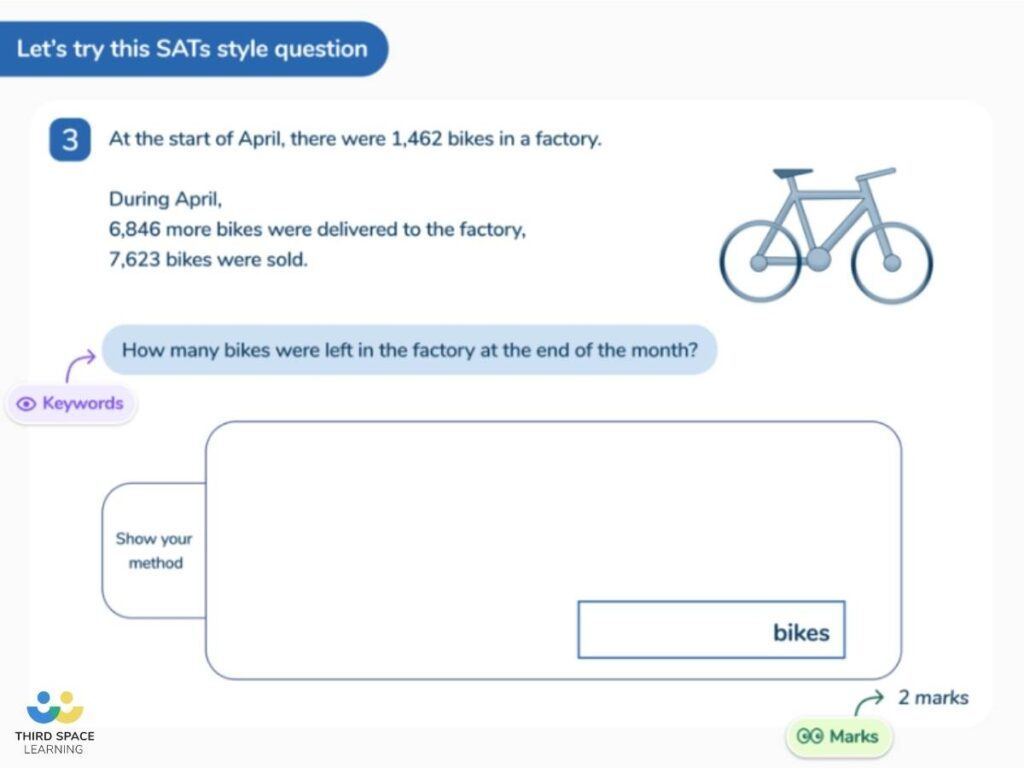
Your school may well face these or other challenges. They’re normal! The important thing is to be aware of the challenges and risks before you commit to your primary school intervention programme. Make sure too that you have a plan in place to combat any foreseeable future problems.
Which sort of maths intervention should you choose?
Since the Covid-19 pandemic and the large scale absences from school, the DfE has been clear that research has found that one to one tutoring is the most effective way to try to support children who’ve fallen behind. That said, schools do still have a choice of different maths intervention approaches which we look at below.
Aside from using intervention teachers (who can be expensive) or TAs (who may not be best qualified), these are the three most popular types of external maths interventions that schools use. In each case, you need to consider very carefully the needs of your pupils and your school to choose the maths intervention programme that’s right for you.
1. Maths websites and online resources
These maths websites are easily accessed and are now being used as a standard “go-to” numeracy intervention when teachers want to give their pupils some additional help but don’t have the time to plan structured and individualised learning interventions.
Pros: The advantage of these is that per pupil they’re usually quite cheap, but they don’t necessarily tackle the real root of any maths misconceptions. Their ‘personalisation’ is often fairly rudimentary and ‘broad brush’ e.g. a child will be offered harder or easier questions to do but they will not necessarily be based on the child’s gaps or misconceptions.
Cons: Although these websites can be good for a short term “quick win”, in the long term children can become disengaged and their learning may not be maximised considering the time they have to spend online.
2. One to one/small group maths tutors
Many teachers report to us that one to one specialist maths tutors would be the intervention of their choice if budgets were unlimited. However for most schools, such an intensive personalised numeracy intervention seems out of reach.
Pros: One to one tuition is probably the most effective way to accelerate progress in maths. A lesson is fully personalised to the needs of the pupil and the pupil is free to ask questions and talk through their understanding at their own pace.
Cons: Face to face one to one tuition can be expensive.
3. Online 1-to-1 maths tuition
At Third Space we recognise that 1-to-1 maths tuition is a great solution for most pupils, but it is often time-consuming and costly; this is why we’ve used technology to take maths tuition online.
Each of the pupils we work with receives their own personal maths specialist tutor for the term, and undertakes a formative diagnostic assessment at the start to create their own individualised sequence of maths lessons that are then delivered by personal tutors.
Pros: All the benefits of 1-to-1 tuition combined with the diagnostic and machine learning technology we have implemented. This ensures that lessons are pitched at the right level for each child and that tutors know what to say and when to move learning on to the next stage.
We put Vygotsky’s theory of the Zone of Proximal Development into practice to achieve rapid progress in a short space of time.
As well as practice on the maths concepts, children are given time and encouragement to explain their answers and justify their reasoning during the lessons, to help them on their journey to mastery.
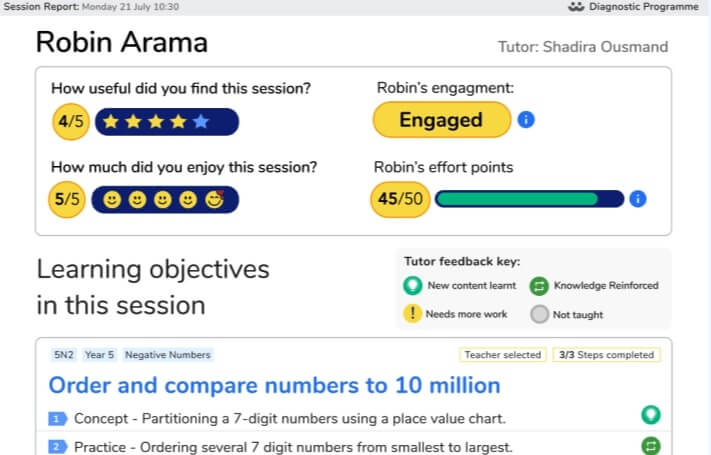
Because of the range of tutors we have available, all maths specialists, and trained in the primary KS2 curriculum we are able to provide online tuition for up to 15 pupils at one time in a school, minimising disruption and making it easy to set up.
Cons: Online one to one maths tuition is not suitable for children with some severe special needs or for children below the age of about 6 or 7. They need to be able to sit and communicate for 45 minutes with a tutor.
Read more about primary school tutoring and KS2 tutoring here.
What next?
Armed with your checklist, and some background on the interventions available, you’re now ready to take giant leaps in improving the maths outcomes for your pupils.
It is our belief that Third Space Learning’s maths intervention is the most effective way to accelerate KS2 pupils’ progress in maths, and the thousands of schools we work with every year are our evidence.
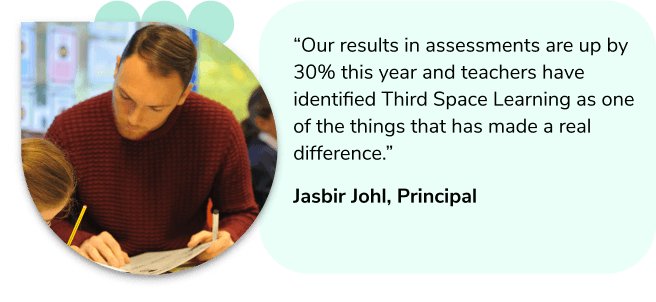
Do you know about the National Tutoring Programme and have you used it?
Third Space Learning was one of the original tuition partners, selected for the quality and consistency of our maths tutors. Find out about the current provision and funding support available for schools from the National Tutoring Programme here.
But you will need to do your own research at this point to decide what is going to work best for your school. A good place to start is by reading reviews from other schools.
When you’re ready, book a 5 minute phone call with one of our extremely friendly schools team and see if Third Space is right for your school.
DO YOU HAVE STUDENTS WHO NEED MORE SUPPORT IN MATHS?
Every week Third Space Learning’s maths specialist tutors support thousands of students across hundreds of schools with weekly maths intervention programmes designed to plug gaps and boost progress.
Since 2013 these personalised one to one lessons have helped over 150,000 primary and secondary students become more confident, able mathematicians.
Learn how we can teach multiple pupils at once or request a personalised quote for your school to speak to us about your school’s needs and how we can help.

